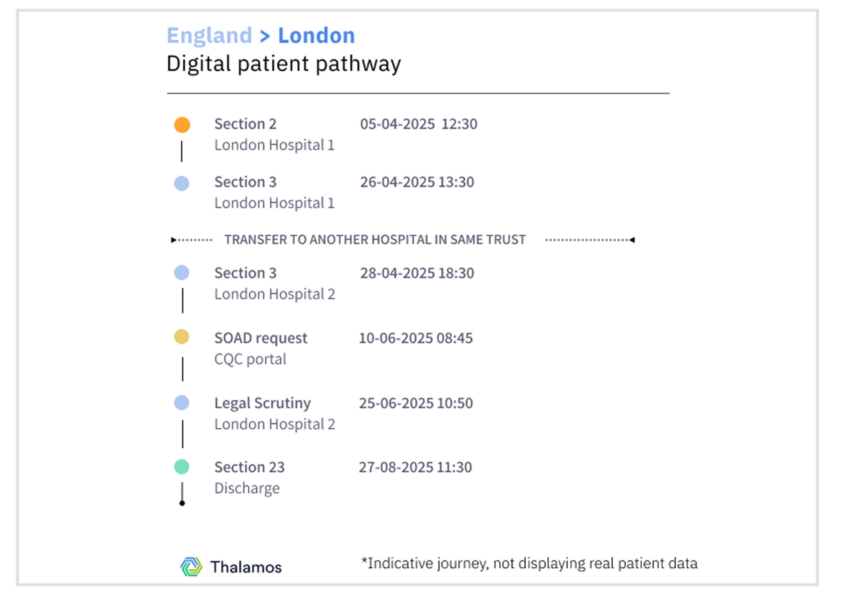
For the first time, a patient journey through the Mental Health Act has been completed digitally. Using eMHA by Thalamos, care professionals were able to digitally admit under section and request authorisation for treatment, ahead of a future discharge.
This development demonstrates what has long been the ambition of mental health professionals, regulators, and digital innovators: an end-to-end digitised pathway that reduces risk, saves time, and ensures information flows seamlessly between those who need it.
How the first journey worked
The real patient journey began when an Approved Mental Health Professional (AMHP) created a patient instance via their Mental Health Trust’s Electronic Patient Record (EPR). The patient was admitted under Section 2 for assessment and treatment, which was recorded in eMHA by Thalamos, before being detained under Section 3, also completed digitally.
With treatment beyond three months requiring authorisation from an independent doctor, a Second Opinion Appointed Doctor (SOAD) was able to securely search for the patient using their NHS number, thanks to the integration with the Personal Demographics Service (PDS) known as part of the NHS Spine. If PDS is used, auto-merge takes the profile created when a SOAD starts an assessment, compares it against the Trust’s profile of the patient, confirms they are the same and merges the SOAD patient profile into the primary Trust patient. When all the information is the same, a Trust receives a simple auto-merge notification and does not then have to do anything for SOAD forms to automatically appear as part of a patient’s form history.
The SOAD completed their assessment and submitted the outcome digitally to the Mental Health Trust. The Trust finalised the process, marked scrutiny as complete, and pushed the documents back into their EPR for archiving. This closed the loop on the first ever fully digital MHA patient journey involving a Local Authority, a Mental Health Trust and a regulatory contribution in the form of a CQC SOAD.
This article features a visual example journey, as seen at the top of the page. The example uses only test patient data created for demonstration purposes. No real patient information has been used.
Why it matters
For decades, MHA processes have relied on paper forms, hand delivery, and multiple points of re-entry into local systems. Each step brought opportunities for delay or error, at moments where timing and accuracy are critical for patient care. By contrast, a digitised pathway ensures that information is accurate, accessible, timely and compliant from the start.
This milestone also signals what is now possible for patients and professionals alike: a system where assessments and authorisations can be completed swifter, simpler, safer and with less administrative burden, allowing more time for direct care.
“This is a step change for mental health services. To see an end-to-end journey completed entirely digitally shows that smarter ways of working are now a reality under the Mental Health Act. This will, in turn, unlock opportunities to deliver insights and improvements in patient experience and outcomes.” said Zoe Seager, Chief Client Officer at Thalamos. “It’s proof of the progress being made across the system, and of the impact that collaboration between providers, regulators and technology partners can deliver.”
Success of the CQC digital product
This milestone is part of a wider transformation driven by the Care Quality Commission (CQC), which has now adopted Thalamos’ new digital product for SOAD assessments. Since its rollout, MHA forms have been issued to 50 providers across England — representing 80% of all Mental Health Trusts in the country.
The scale and speed of adoption highlight the appetite for digital products that improve compliance and reduce risk. It also reflects the success of a regulatory body taking a proactive role in modernising the Mental Health Act ecosystem.
Looking ahead
Digitisation of the MHA is no longer an aspiration, but an established reality. As more Trusts, AMHPs, SOADs and administrators use digital systems, the benefits will compound. Fewer errors, faster communication, and more joined-up care.


